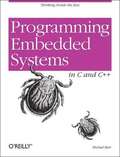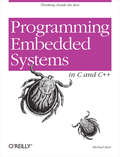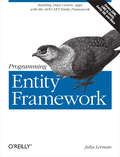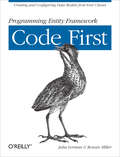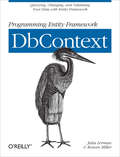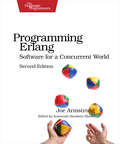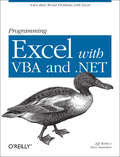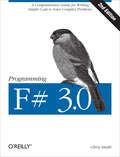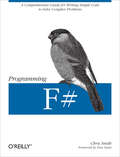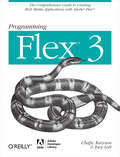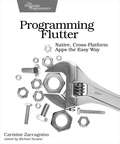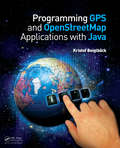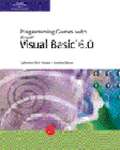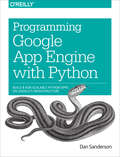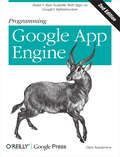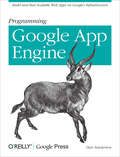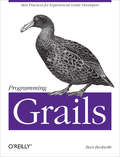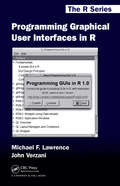- Table View
- List View
Programming Embedded Systems in C and C++
by Michael BarrThis book introduces embedded systems to C and C++ programmers. Topics include testing memory devices, writing and erasing Flash memory, verifying nonvolatile memory contents, controlling on-chip peripherals, device driver design and implementation, optimizing embedded code for size and speed, and making the most of C++ without a performance penalty.
Programming Embedded Systems: With C and GNU Development Tools
by Michael Barr Anthony MassaIf you have programming experience and a familiarity with C--the dominant language in embedded systems--Programming Embedded Systems, Second Edition is exactly what you need to get started with embedded software. This software is ubiquitous, hidden away inside our watches, DVD players, mobile phones, anti-lock brakes, and even a few toasters. The military uses embedded software to guide missiles, detect enemy aircraft, and pilot UAVs. Communication satellites, deep-space probes, and many medical instruments would have been nearly impossible to create without embedded software.The first edition of Programming Embedded Systems taught the subject to tens of thousands ofpeople around the world and is now considered the bible of embedded programming. This second edition has been updated to cover all the latest hardware designs and development methodologies.The techniques and code examples presented here are directly applicable to real-world embedded software projects of all sorts. Examples use the free GNU software programming tools, the eCos and Linux operating systems, and a low-cost hardware platform specially developed for this book. If you obtain these tools along withProgramming Embedded Systems, Second Edition, you'll have a full environment for exploring embedded systems in depth. But even if you work with different hardware and software, the principles covered in this bookapply.Whether you are new to embedded systems or have done embedded work before, you'll benefit from the topics in this book, which include:How building and loading programs differ from desktop or servercomputersBasic debugging techniques--a critical skill when working withminimally endowed embedded systemsHandling different types of memoryInterrupts, and the monitoring and control of on-chip and externalperipheralsDetermining whether you have real-time requirements, and whetheryour operating system and application can meet those requirementsTask synchronization with real-time operating systems and embeddedLinuxOptimizing embedded software for size, speed, and power consumptionWorking examples for eCos and embedded LinuxSo whether you're writing your first embedded program, designing thelatest generation of hand-held whatchamacalits, or managing the peoplewho do, this book is for you. Programming EmbeddedSystems will help you develop the knowledge and skills youneed to achieve proficiency with embedded software.Praise for the first edition:"This lively and readable book is the perfect introduction for those venturing into embedded systems software development for the first time. It provides in one place all the important topics necessary to orient programmers to the embedded development process.--Lindsey Vereen, Editor-in-Chief, Embedded Systems Programming
Programming Entity Framework: Building Data Centric Apps with the ADO.NET Entity Framework (Oreilly And Associate Ser.)
by Julia LermanGet a thorough introduction to ADO.NET Entity Framework 4 -- Microsoft's core framework for modeling and interacting with data in .NET applications. The second edition of this acclaimed guide provides a hands-on tour of the framework latest version in Visual Studio 2010 and .NET Framework 4. Not only will you learn how to use EF4 in a variety of applications, you'll also gain a deep understanding of its architecture and APIs.Written by Julia Lerman, the leading independent authority on the framework, Programming Entity Framework covers it all -- from the Entity Data Model and Object Services to WCF Services, MVC Apps, and unit testing. This book highlights important changes for experienced developers familiar with the earlier version.Understand the core concepts you need to make the best use of the EF4 in your applicationsLearn to query your data, using either LINQ to Entities or Entity SQLCreate Windows Forms, WPF, ASP.NET Web Forms, and ASP.NET MVC applicationsBuild and consume WCF Services, WCF Data Services, and WCF RIA ServicesUse Object Services to work directly with your entity objectsCreate persistent ignorant entities, repositories, and write unit testsDelve into model customization, relationship management, change tracking, data concurrency, and moreGet scores of reusable examples -- written in C# (with notes on Visual Basic syntax) -- that you can implement right away
Programming Entity Framework: Code First
by Julia LermanIf you use Entity Framework in Visual Studio 2008 and .NET 3.5, this is the book you want. Programming Entity Framework, 1st Edition offers experienced developers a thorough introduction to Microsoft's core framework for modeling and interacting with data in .NET applications. This hands-on tour provides a deep understanding of Entity Framework's architecture and APIs, and explains how to use the framework in a variety of applications built with Visual Studio 2008 and .NET 3.5.From the Entity Data Model (EDM) and Object Services to EntityClient and the Metadata Workspace, this highly acclaimed first edition covers it all.Understand the core concepts you need to make the best use of the Entity Framework (EF) in your applicationsLearn to query your data, using either LINQ to Entities or Entity SQLCreate Windows Forms, WPF, and ASP.NET applicationsBuild ASMX web services and WCF servicesUse Object Services to work directly with your entity objectsDelve into model customization, relationship management, change tracking, data concurrency, and moreOne important note: while many of the lessons from this book will continue to be valuable as you move to .NET 4, the thoroughly revised second edition of Programming Entity Framework (August 2010) specifically targets Visual Studio 2010 and .NET 4 -- where there have been many advancements and additions to the framework.
Programming Entity Framework: Creating and Configuring Data Models from Your Classes
by Julia Lerman Rowan MillerTake advantage of the Code First data modeling approach in ADO.NET Entity Framework, and learn how to build and configure a model based on existing classes in your business domain. With this concise book, you’ll work hands-on with examples to learn how Code First can create an in-memory model and database by default, and how you can exert more control over the model through further configuration.Code First provides an alternative to the database first and model first approaches to the Entity Data Model. Learn the benefits of defining your model with code, whether you’re working with an existing database or building one from scratch. If you work with Visual Studio and understand database management basics, this book is for you.Learn exactly what Code First does—and does not—enable you to doUnderstand how property attributes, relationships, and database mappings are inferred from your classes by Code FirstUse Data Annotations and the Fluent API to configure the Code First data modelPerform advanced techniques, such as controlling the database schema and overriding the default model cachingThis book is a continuation of author Julia Lerman’s Programming Entity Framework, widely recognized as the leading book on the topic.
Programming Entity Framework: Querying, Changing, and Validating Your Data with Entity Framework (Oreilly And Associate Ser.)
by Julia Lerman Rowan MillerThe DbContext API captures Entity Framework’s (EF) most commonly used features and tasks, simplifying development with EF. This concise book shows you how to use the API to perform set operations with the DbSet class, handle change tracking and resolve concurrency conflicts with the Change Tracker API, and validate changes to your data with the Validation API.With DbContext, you’ll be able to query and update data, whether you’re working with individual objects or graphs of objects and their related data. You’ll find numerous C# code samples to help you get started. All you need is experience with Visual Studio and database management basics.Use EF’s query capabilities to retrieve data, and use LINQ to sort and filter dataLearn how to add new data, and change and delete existing dataUse the Change Tracker API to access information EF keeps about the state of entity instancesControl change tracking information of entities in disconnected scenarios, including NTier applicationsValidate data changes before they’re sent to the database, and set up validation rulesBypass EF’s query pipeline and interact directly with the database
Programming Erlang: Software for a Concurrent World
by Joe ArmstrongA multi-user game, web site, cloud application, or networked database can have thousands of users all interacting at the same time. You need a powerful, industrial-strength tool to handle the really hard problems inherent in parallel, concurrent environments. You need Erlang. In this second edition of the bestselling Programming Erlang, you'll learn how to write parallel programs that scale effortlessly on multicore systems.Using Erlang, you'll be surprised at how easy it becomes to deal with parallel problems, and how much faster and more efficiently your programs run. That's because Erlang uses sets of parallel processes-not a single sequential process, as found in most programming languages. Joe Armstrong, creator of Erlang, introduces this powerful language in small steps, giving you a complete overview of Erlang and how to use it in common scenarios. You'll start with sequential programming, move to parallel programming and handling errors in parallel programs, and learn to work confidently with distributed programming and the standard Erlang/Open Telecom Platform (OTP) frameworks. You need no previous knowledge of functional or parallel programming. The chapters are packed with hands-on, real-world tutorial examples and insider tips and advice, and finish with exercises for both beginning and advanced users.The second edition has been extensively rewritten. New to this edition are seven chapters covering the latest Erlang features: maps, the type system and the Dialyzer, WebSockets, programming idioms, and a new stand-alone execution environment. You'll write programs that dynamically detect and correct errors, and that can be upgraded without stopping the system. There's also coverage of rebar (the de facto Erlang build system), and information on how to share and use Erlang projects on github, illustrated with examples from cowboy and bitcask.Erlang will change your view of the world, and of how you program. What You NeedThe Erlang/OTP system. Download it from erlang.org.
Programming Excel with VBA and .NET: Solve Real-World Problems with Excel
by Jeff Webb Steve SaundersWhy program Excel? For solving complex calculations and presenting results, Excel is amazingly complete with every imaginable feature already in place. But programming Excel isn't about adding new features as much as it's about combining existing features to solve particular problems. With a few modifications, you can transform Excel into a task-specific piece of software that will quickly and precisely serve your needs. In other words, Excel is an ideal platform for probably millions of small spreadsheet-based software solutions. The best part is, you can program Excel with no additional tools. A variant of the Visual Basic programming language, VB for Applications (VBA) is built into Excel to facilitate its use as a platform. With VBA, you can create macros and templates, manipulate user interface features such as menus and toolbars, and work with custom user forms or dialog boxes. VBA is relatively easy to use, but if you've never programmed before, Programming Excel with VBA and .NET is a great way to learn a lot very quickly. If you're an experienced Excel user or a Visual Basic programmer, you'll pick up a lot of valuable new tricks. Developers looking forward to .NET development will also find discussion of how the Excel object model works with .NET tools, including Visual Studio Tools for Office (VSTO). This book teaches you how to use Excel VBA by explaining concepts clearly and concisely in plain English, and provides plenty of downloadable samples so you can learn by doing. You'll be exposed to a wide range of tasks most commonly performed with Excel, arranged into chapters according to subject, with those subjects corresponding to one or more Excel objects. With both the samples and important reference information for each object included right in the chapters, instead of tucked away in separate sections, Programming Excel with VBA and .NET covers the entire Excel object library. For those just starting out, it also lays down the basic rules common to all programming languages. With this single-source reference and how-to guide, you'll learn to use the complete range of Excel programming tasks to solve problems, no matter what you're experience level.
Programming Excel with VBA: A Practical Real-World Guide
by Flavio MorgadoLearn to harness the power of Visual Basic for Applications (VBA) in Microsoft Excel to develop interesting, useful, and interactive Excel applications. This book will show you how to manipulate Excel with code, allowing you to unlock extra features, accuracy, and efficiency in working with your data. Programming Excel 2016 with VBA is a complete guide to Excel application development, using step-by-step guidance, example applications, and screenshots in Excel 2016.In this book, you will learn:How to interact with key Excel objects, such as the application object, workbook object, and range objectMethods for working with ranges in detail using codeUsage of Excel as a database repositoryHow to exchange data between Excel applicationsHow to use the Windows API to expand the capabilities of ExcelA step-by-step method for producing your own custom Excel ribbonWho This Book Is For:Developers and intermediate-to-advanced Excel users who want to dive deeper into the capabilities of Excel 2016 using code.
Programming Excel® Services
by Alvin BruneyLearn how to use Excel Services to add spreadsheets and workbooks to your enterprise dashboards and portals. You get real-world examples and code samples to help you enable business intelligence on Microsoft Office SharePoint Server 2007 applications--and simplify information sharing and reuse. Discover how to: Configure Windows SharePoint Products and Technologies, and provision Excel Services Build and debug Web Parts derived from Microsoft .NET Framework or SharePoint base classes Customize and embed objects into Web Parts Extract workbook contents and bind the results to user interface controls with Excel Web Services Load workbooks, perform calculations, and refresh data using Excel Calculation Service Configure Code Access Security for managed user controls Use asynchronous Web Parts to automate Microsoft Office applications PLUS--Get Microsoft Visual C# and Visual Basic code samples on the Web
Programming F# 3.0: A Comprehensive Guide for Writing Simple Code to Solve Complex Problems
by Chris SmithWhy learn F#? With this guide, you’ll learn how this multi-paradigm language not only offers you an enormous productivity boost through functional programming, but also lets you develop applications using your existing object-oriented and imperative programming skills. You’ll quickly discover the many advantages of the language, including access to all the great tools and libraries of the .NET platform.Reap the benefits of functional programming for your next project, whether you’re writing concurrent code, or building data- or math-intensive applications. With this comprehensive book, former F# team member Chris Smith gives you a head start on the fundamentals and walks you through advanced concepts of the F# language.Learn F#’s unique characteristics for building applicationsGain a solid understanding of F#’s core syntax, including object-oriented and imperative stylesMake your object-oriented code better by applying functional programming patternsUse advanced functional techniques, such as tail-recursion and computation expressionsTake advantage of multi-core processors with asynchronous workflows and parallel programmingUse new type providers for interacting with web services and information-rich environmentsLearn how well F# works as a scripting language
Programming F#: A comprehensive guide for writing simple code to solve complex problems (Animal Guide)
by Chris SmithWhy learn F#? This multi-paradigm language not only offers you an enormous productivity boost through functional programming, it also lets you develop applications using your existing object-oriented and imperative programming skills. With Programming F#, you'll quickly discover the many advantages of Microsoft's new language, which includes access to all the great tools and libraries of the .NET platform. Learn how to reap the benefits of functional programming for your next project -- whether it's quantitative computing, large-scale data exploration, or even a pursuit of your own. With this comprehensive guide, F# team member Chris Smith gives you a head start on the fundamentals and advanced concepts of the F# language.Get a clear understanding of functional programming, and how you can use it to simplify code Gain a solid understanding of the language's core syntax, including object-oriented and imperative styles Simplify concurrent and parallel programming with F# Asynchronous Workflows and the Parallel Extensions to .NET Learn advanced F# concepts, such as quotations and computation expressions "This book emphasizes simple, clear explanations of the foundational elements of F#, always with an eye on the enjoyment that comes from programming in general, and programming with F# in particular." Don Syme, Principal Researcher and F# Designer, Microsoft Research
Programming Firefox
by Kenneth C. FeldtThis is your guide to building Internet applications and user interfaces with the Mozilla component framework, which is best known for the Firefox web browser and Thunderbird email client. Programming Firefox demonstrates how to use the XML User Interface Language (XUL) with open source tools in the framework's Cross-Platform Component (XPCOM) library to develop a variety of projects, such as commercial web applications and Firefox extensions. This book serves as both a programmer's reference and an in-depth tutorial, so not only do you get a comprehensive look at XUL's capabilities--from simple interface design to complex, multitier applications with real-time operations--but you also learn how to build a complete working application with XUL. If you're coming from a Java or .NET environment, you'll be amazed at how quickly large-scale applications can be constructed with XPCOM and XUL. Topics in Programming Firefox include: An overview of Firefox technology An introduction to the graphical elements that compose a XUL application Firefox development tools and the process used to design and build applications Managing an application with multiple content areas Introduction to Resource Description Files, and how the Firefox interface renders RDF Manipulating XHTML with JavaScript Displaying documents using the Scalable Vector Graphics standard and HTML Canvas The XML Binding Language and interface overlays to extend Firefox Implementing the next-generation forms interface through XForms Programming Firefox is ideal for the designer or developer charged with delivering innovative standards-based Internet applications, whether they're web server applications or Internet-enabled desktop applications. It's not just a how-to book, but a what-if exploration that encourages you to push the envelope of the Internet experience.
Programming Flex 2: The Comprehensive Guide to Creating Rich Internet Applications with Adobe Flex
by Joey Lott Chafic KazounIs there an easier way to build and deliver rich internet applications (RIAs) other than the Flash IDE or Ajax? Absolutely. With Adobe Flex 2, the Flex 2 SDK, and this book, you have all you need to build RIAs. Programming Flex 2 offers you plenty of practical and useful examples that reveal how and why to use a particular feature of Flex 2, and when and when not to. As part of the Adobe Developer Library, Programming Flex 2 is the authoritative guide to this new Adobe framework. You learn to use a markup language called MXML and a vast library of off-the-shelf and highly-configurable components to build Flash-based applications that combine the immediacy of the Web with the functionality and responsiveness of desktop applications. You also discover why -- with the Flash Player runtime environment and the powerful ActionScript 3.0 programming language -- the possibilities with Flex 2 are nearly limitless. Topics include: Managing LayoutWorking with ComponentsWorking with MediaManaging StateUsing Transitions and EffectsWorking with DataCustomizing Application AppearanceClient Data Communication and Remote Data CommunicationDebugging Flex Framework ApplicationsCreating Custom Components Flex may be easier to learn than the Flash IDE, but you still need a reliable guide to the framework. Programming Flex 2 not only serves as a reference, but provides valuable and practical insight into this new technology. As you learn how to build Flex applications, you'll also discover how Flex works. This book supplies all the information you need in one convenient place. Adobe Developer Library is a co-publishing partnership between O'Reilly Media and Adobe Systems, Inc. and is designed to produce the number one information resources for developers who use Adobe technologies. Created in 2006, the Adobe Developer Library is the official source for comprehensive learning solutions to help developers create expressive and interactive web applications that can reach virtually anyone on any platform. With top-notch books and innovative online resources covering the latest in rich Internet application development, the Adobe Developer Library offers expert training and in-depth resources, straight from the source.
Programming Flex 3: The Comprehensive Guide to Creating Rich Internet Applications with Adobe Flex
by Joey Lott Chafic KazounIf you want to try your hand at developing rich Internet applications with Adobe's Flex 3, and already have experience with frameworks such as .NET or Java, this is the ideal book to get you started. Programming Flex 3 gives you a solid understanding of Flex 3's core concepts, and valuable insight into how, why, and when to use specific Flex features. Numerous examples and sample code demonstrate ways to build complete, functional applications for the Web, using the free Flex SDK, and RIAs for the desktop, using Adobe AIR. This book is an excellent companion to Adobe's Flex 3 reference documentation. With this book, you will:Learn the underlying details of the Flex frameworkProgram with MXML and ActionScriptArrange the layout and deal with UI componentsWork with mediaManage state for applications and componentsUse transitions and effectsDebug your Flex applicationsCreate custom componentsEmbed Flex applications in web browsersBuild AIR applications for the desktopFlex 3 will put you at the forefront of the RIA revolution on both the Web and the desktop. Programming Flex 3 will help you get the most from this amazing and sophisticated technology.
Programming Flutter: Native, Cross-Platform Apps the Easy Way
by Carmine ZaccagninoWork in Flutter, a framework designed from the ground up for dual platform development, with support for native Java/Kotlin or Objective-C/Swift methods from Flutter apps. Write your next app in one language and build it for both Android and iOS. Deliver the native look, feel, and performance you and your users expect from an app written with each platform's own tools and languages. Deliver apps fast, doing half the work you were doing before and exploiting powerful new features to speed up development. Write once, run anywhere. Learn Flutter, Google's multi-platform mobile development framework. Instantly view the changes you make to an app with stateful hot reload and define a declarative UI in the same language as the app logic, without having to use separate XML UI files. You can also reuse existing platform-specific Android and iOS code and interact with it in an efficient and simple way. Use built-in UI elements - or build your own - to create a simple calculator app. Run native Java/Kotlin or Objective-C/Swift methods from your Flutter apps, and use a Flutter package to make HTTP requests to a Web API or to perform read and write operations on local storage. Apply visual effects to widgets, create transitions and animations, create a chat app using Firebase, and deploy everything on both platforms. Get native look and feel and performance in your Android and iOS apps, and the ability to build for both platforms from a single code base. What You Need: Flutter can be used for Android development on any Linux, Windows or macOS computer, but macOS is needed for iOS development.
Programming GPS and OpenStreetMap Applications with Java: The RealObject Application Framework
by Kristof BeiglböckWritten by an expert in the development of GPS systems with digital maps and navigation, Programming GPS and OpenStreetMap Applications with Java: The RealObject Application Framework provides a concrete paradigm for object-oriented modeling and programming. It presents a thorough introduction to the use of available global positioning data for the
Programming Games With Microsoft Visual Basic 6.0
by Catherine Muir Dwyer Jeanine MeyerStudents will learn important programming concepts while creating fun thought-provoking games like Minesweeper, Hangman, and Memory.
Programming Google App Engine with Java: Build & Run Scalable Java Applications on Google's Infrastructure
by Dan SandersonThis practical guide shows intermediate and advanced web and mobile app developers how to build highly scalable Java applications in the cloud with Google App Engine. The flagship of Google's Cloud Platform, App Engine hosts your app on infrastructure that grows automatically with your traffic, minimizing up-front costs and accommodating unexpected visitors. You’ll learn hands-on how to perform common development tasks with App Engine services and development tools, including deployment and maintenance.For Java applications, App Engine provides a J2EE standard servlet container with a complete Java 7 JVM and standard library. Because App Engine supports common Java API standards, your code stays clean and portable.Get a hands-on introduction to App Engine's tools and features, using an example applicationSimulate App Engine on your development machine directly from EclipseStructure your app into individually addressable modules, each with its own scaling configurationExploit the power of the scalable Cloud Datastore, using queries, transactions, and data modeling with JPAUse Cloud SQL for standard relational databases with App Engine applicationsLearn how to deploy, manage, and inspect your application on Google infrastructure
Programming Google App Engine with Python: Build and Run Scalable Python Apps on Google's Infrastructure
by Dan SandersonThis practical guide shows intermediate and advanced web and mobile app developers how to build highly scalable Python applications in the cloud with Google App Engine. The flagship of Google's Cloud Platform, App Engine hosts your app on infrastructure that grows automatically with your traffic, minimizing up-front costs and accommodating unexpected visitors. You’ll learn hands-on how to perform common development tasks with App Engine services and development tools, including deployment and maintenance.App Engine's Python support includes a fast Python 2.7 interpreter, the standard library, and a WSGI-based runtime environment. Choose from many popular web application frameworks, including Django and Flask.Get a hands-on introduction to App Engine's tools and features, using an example applicationSimulate App Engine on your development machine with tools from Google Cloud SDKStructure your app into individually addressable modules, each with its own scaling configurationExploit the power of the scalable Cloud Datastore, using queries, transactions, and data modeling with the ndb libraryUse Cloud SQL for standard relational databases with App Engine applicationsLearn how to deploy, manage, and inspect your application on Google infrastructure
Programming Google App Engine: Build & Run Scalable Web Applications on Google's Infrastructure (Animal Guide Ser.)
by Dan SandersonGoogle App Engine makes it easy to create a web application that can serve millions of people as easily as serving hundreds, with minimal up-front investment. With Programming Google App Engine, Google engineer Dan Sanderson provides practical guidance for designing and developing your application on Google’s vast infrastructure, using App Engine’s scalable services and simple development model.Through clear and concise instructions, you’ll learn how to get the most out of App Engine’s nearly unlimited computing power. This second edition is fully updated and expanded to cover Python 2.7 and Java 6 support, multithreading, asynchronous service APIs, and the use of frameworks such as Django 1.3 and webapp2.Understand how App Engine handles web requests and executes application codeLearn about new datastore features for queries and indexes, transactions, and data modelingCreate, manipulate, and serve large data files with the BlobstoreUse task queues to parallelize and distribute computation across the infrastructureEmploy scalable services for email, instant messaging, and communicating with web servicesTrack resource consumption, and optimize your application for speed and cost effectiveness
Programming Google App Engine: Build and Run Scalable Web Apps on Google's Infrastructure (Animal Guide)
by Dan SandersonAs one of today's cloud computing services, Google App Engine does more than provide access to a large system of servers. It also offers you a simple model for building applications that scale automatically to accommodate millions of users. With Programming Google App Engine, you'll get expert practical guidance that will help you make the best use of this powerful platform. Google engineer Dan Sanderson shows you how to design your applications for scalability, including ways to perform common development tasks using App Engine's APIs and scalable services. You'll learn about App Engine's application server architecture, runtime environments, and scalable datastore for distributing data, as well as techniques for optimizing your application. App Engine offers nearly unlimited computing power, and this book provides clear and concise instructions for getting the most from it right from the source. Discover the differences between traditional web development and development with App EngineLearn the details of App Engine's Python and Java runtime environmentsUnderstand how App Engine handles web requests and executes application codeLearn how to use App Engine's scalable datastore, including queries and indexes, transactions, and data modelingUse task queues to parallelize and distribute work across the infrastructureDeploy and manage applications with ease
Programming Grails: Best Practices for Experienced Grails Developers
by Burt BeckwithDig deeper into Grails architecture and discover how this application framework works its magic. Written by a core developer on the Grails team, this practical guide takes you behind the curtain to reveal the inner workings of its 2.0 feature set. You’ll learn best practices for building and deploying Grails applications, including performance, security, scaling, tuning, debugging, and monitoring.Understand how Grails integrates with Groovy, Spring, Hibernate, and other JVM technologies, and learn how to create and use plugins to augment your application’s functionality. Once you know how Grails adds behavior by convention, you can solve problems more easily and develop applications more intuitively.Write simpler, more powerful code with the Groovy languageManage persistence in Grails, using Hibernate or a NoSQL datastoreLearn how Grails uses Spring’s functionality and optional modulesDiscover how Hibernate handles details for storing and retrieving dataIntegrate technologies for messaging, mail, creating web services, and other JEE technologiesBypass convention and configure Grails manuallyLearn a general approach to upgrading applications and pluginsUse Grails to develop and deploy IaaS and PaaS applications
Programming Graphical User Interfaces in R (Chapman & Hall/CRC The R Series #5)
by Michael Lawrence John VerzaniProgramming Graphical User Interfaces with R introduces each of the major R packages for GUI programming: RGtk2, qtbase, Tcl/Tk, and gWidgets. With examples woven through the text as well as stand-alone demonstrations of simple yet reasonably complete applications, the book features topics especially relevant to statisticians who aim to provide a practical interface to functionality implemented in R. The book offers: A how-to guide for developing GUIs within R The fundamentals for users with limited knowledge of programming within R and other languages GUI design for specific functions or as learning tools The accompanying package, ProgGUIinR, includes the complete code for all examples as well as functions for browsing the examples from the respective chapters. Accessible to seasoned, novice, and occasional R users, this book shows that for many purposes, adding a graphical interface to one’s work is not terribly sophisticated or time consuming.
Programming Groovy 2: Dynamic Productivity for the Java Developer
by Venkat SubramaniamGroovy brings you the best of both worlds: a flexible, highly productive, agile, dynamic language that runs on the rich framework of the Java Platform. Groovy preserves the Java semantics and extends the JDK to give you true dynamic language capabilities. Programming Groovy 2 will help you, the experienced Java developer, learn and take advantage of the latest version of this rich dynamic language. You'll go from the basics of Groovy to the latest advances in the language, including options for type checking, tail-call and memoization optimizations, compile time metaprogramming, and fluent interfaces to create DSLs. You don't have to leave the rich Java Platform to take advantage of Groovy. Groovy preserves Java's semantics and extends the JDK, so programming in Groovy feels like the Java language has been augmented; it's like working with a lighter, more elegant Java. If you're an experienced Java developer who wants to learn how Groovy works, you'll find exactly what you need in this book.You'll start with the fundamentals of programming in Groovy and how it works with Java, and then you'll explore advanced concepts such as unit testing with mock objects, using Builders, working with databases and XML, and creating DSLs. You'll master Groovy's powerful yet complex run-time and compile-time metaprogramming features.Much has evolved in the Groovy language since the publication of the first edition of Programming Groovy. Programming Groovy 2 will help you learn and apply Groovy's new features. Creating DSLs is easier now, and Groovy's already-powerful metaprogramming facilities have improved even more. You'll see how to work with closures, including tail call optimization and memoization. The book also covers Groovy's new static compilation feature.Whether you're learning the basics of the language or interested in getting proficient with the new features, Programming Groovy 2 has you covered.What You NeedTo work on the examples in the book you need Groovy 2.0.5 and Java JDK 5 or higher.
